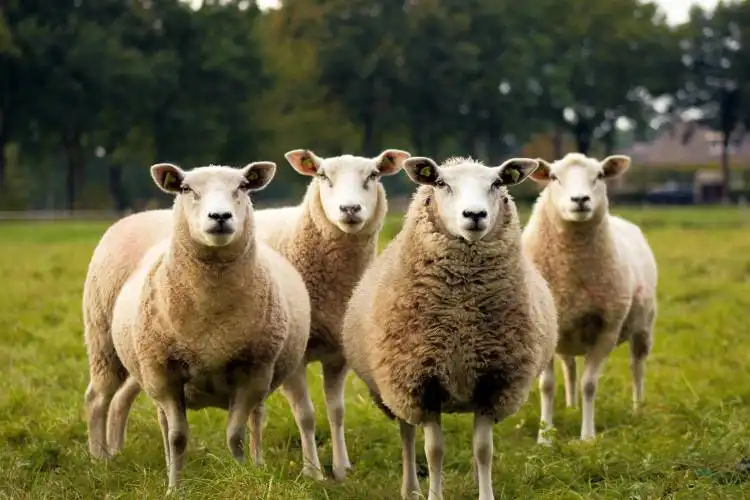Start a Cattle Ranch Business
Embracing the Cowboy Way: Your Blueprint for a Thriving Cattle Ranch Business
| Updated


CATTLE RANCH BUSINESS
For those who enjoy wide open spaces and have a fondness for our bovine friends, a cattle ranch business could be a perfect fit. This type of business involves breeding, raising, and marketing cattle primarily for meat production. You'll need to cultivate your herd's genetic traits with care, ensuring optimal health for premium quality meat. It's not just about cowboys and roping, it's an age-old enterprise that involves strategic planning, animal health care, and a deep understanding of market trends.
Jump to Business Plan
RELATED BUSINESS IDEAS
Browse ALL Pets & Animals Business Ideas
Discover Your Perfect Domain
Unlock the door to your online success with our hand-picked selection of premium domain names. Whether you're starting a new venture or rebranding an existing one, the right domain can set the tone for your digital presence. Browse through our curated list, each with its unique potential to enhance your brand's visibility and credibility.
CATTLE RANCH MINI BUSINESS PLAN
This a quick reality check to help you identify the strengths and weaknesses of your business concept before you dive in.
Expected Percent Margin:
- Gross Margin: 40-50%
- Net Profit Margin: 10-15%
Earnings Expectations:
- Daily Earnings: Average cattle ranch incomes vary greatly, but expect $100 - $300
- Weekly Earnings: $700 - $2100
- Monthly Earnings: $3000 - $9000
- Annual Earnings: $36,000 - $108,000
Actions to Hit Those Numbers:
Herd Management:
- Initial Herd Purchase: Aim to start with at least 20-40 cattle, depending on the size of your ranch and available resources.
- Cattle Health: Maintain good relationship with a large animal veterinarian. Regular health check-ups are essential.
Ranch Operations:
- Feed: Expect to budget heavily for feed, particularly in winter months.
- Labor: Depending on the size of your ranch, consider 1-2 full or part-time employees.
- Facility Maintenance: Regular upkeep of fences, buildings, and other ranch infrastructure is critical.
Marketing and Sales:
- Direct Sales: Consider selling beef directly to consumers, as this often provides the best margins.
- Wholesale/Retail Relationships: Establish relationships with local butcher shops, restaurants, and grocery stores.
Risk Management:
- Insurance: Invest in comprehensive farm and ranch insurance.
- Budgeting for Downturns: Set aside a portion of good year profits to weather downturns in the market or unexpected costs.
Remember, these numbers are just ballpark figures and actual earnings can vary largely based on the size of your herd, your ability to market your product, and the region in which you operate. It's always a wise idea to consult with a financial advisor or seasoned rancher to better understand the potential expenses and income.
NOT WHAT YOU HAD IN MIND? Here are more ideas



Browse ALL Pets & Animals Business Ideas
Grab Your Business Website Name
Before you get caught up in the whirlwind of setting up your business, invest in a domain name. It's a small but significant step that lays the foundation for your brand and makes it easier for customers to find and trust you. Just like you wouldn't build a house without securing the land first, don't build a business without securing your domain name.
"Why? Can't that wait?" Here's why it shouldn't
Step 1: Determine if Cattle Ranch Business is Right for You
Breakdown of Startup Expenses
Before you begin the process of starting a cattle ranch business, you should take the time to determine if it is the right endeavor for you. This includes assessing the startup costs associated with the business. Startup expenses can include land purchase or leasing, fencing, cattle, equipment, and other necessary supplies. Additionally, you may need to hire employees or contractors to help with the daily operations of the business. All of these costs should be taken into consideration when determining if the business is right for you.
Breakdown of Ongoing Expenses
In addition to the startup expenses, you should also consider the ongoing expenses associated with running a cattle ranch business. These expenses can include feed, veterinary care, labor costs, and other operational expenses. Additionally, you should factor in the cost of marketing and advertising to help promote your business. All of these costs should be taken into consideration when determining if the business is right for you.
Examples of Ways to Make Money
Once you have determined that the cattle ranch business is right for you, you should consider the various ways to make money. This can include selling cattle, selling beef, and selling other products such as leather or wool. Additionally, you may be able to offer services such as guided tours or educational programs. All of these potential sources of income should be taken into consideration when determining if the business is right for you.
Step 2: Naming the Business
When it comes to naming a business, it is important to choose a name that is memorable and reflects the mission and vision of the business. It should also be easy to pronounce and spell. Additionally, it is important to make sure the name is not already taken by another business. To ensure this, it is a good idea to do a trademark search. This can be done by searching the United States Patent and Trademark Office database. It is also important to make sure the domain name is available. Once the name is chosen, it is important to register the business name with the state and obtain any necessary licenses and permits.
Benefits of Naming the Business
Naming the business is an important step in the process of starting a cattle ranch business. Having a name that is unique and memorable can help to create a strong brand identity. It can also help to differentiate the business from its competitors. Additionally, having a name that is easy to pronounce and spell can help to make it easier for customers to find the business. Finally, registering the business name with the state and obtaining the necessary licenses and permits can help to protect the business from legal issues.
Step 3: Obtain Necessary Licenses and Permits
Before you can begin operating your cattle ranch business, you must obtain the necessary licenses and permits. Depending on the size of your operation, you may need to obtain a business license, a zoning permit, and a permit to operate a cattle ranch. You may also need to obtain a permit to use any land that you plan to use for grazing. Additionally, you may need to obtain a permit to transport your cattle to and from the ranch. It is important to research the specific licenses and permits that are required in your area. Once you have obtained all of the necessary licenses and permits, you can move on to the next step.
Step 4: Find a Location
The location of your cattle ranch is an important factor to consider when starting a cattle ranch business. You will need to find a location that is suitable for grazing and has access to a water source. You should also consider the distance to the nearest market, as this will affect the cost of transporting your cattle. Additionally, you should research the zoning laws in the area to make sure that your cattle ranch is in compliance with local regulations. Once you have found a suitable location, you can move on to the next step.
Step 5: Purchase Equipment and Supplies
Once you have found a suitable location for your cattle ranch, you will need to purchase the necessary equipment and supplies. This may include fencing, feeders, water troughs, and other supplies. You will also need to purchase any necessary tools and equipment for caring for your cattle, such as a tractor, hay baler, and other items. Additionally, you may need to purchase a truck or trailer for transporting your cattle. Once you have purchased all of the necessary equipment and supplies, you can move on to the next step.
Step 4: Choose a Location
Choosing the right location for a cattle ranch business is an important decision. The location should have access to water, land, and other resources. It should also be close to a market for selling the cattle and other products. Additionally, the land should be suitable for raising cattle and have adequate grazing land. It is important to research the local zoning laws and regulations to ensure that the business is compliant with all local laws. Additionally, the local climate should be suitable for the type of cattle being raised. The location should also be accessible for employees and customers. Finally, it is important to consider the cost of land and other resources in the area.
Step 5: Acquire Land
The fifth step in starting a cattle ranch business is to acquire the land. It is important to find land that is suitable for raising cattle. This means finding land with adequate water, grass, and shelter for the cattle. Additionally, it is important to consider the size of the land and the cost of purchasing it. The size of the land will depend on the size of the herd that is planned to be raised. It is important to research the zoning laws in the area to ensure that the land is zoned for agricultural use. It is also important to consider the cost of fencing, as well as the cost of any additional structures that may need to be built. Finally, it is important to research the local market to ensure that the land is a good investment.
Step 6: Purchase Cattle
When it comes to purchasing cattle for a cattle ranch business, there are a few important factors to consider. First, it is important to research the breed of cattle that is best suited for the climate and terrain of the area. Different breeds of cattle have different needs and will require different types of feed and care. Additionally, it is important to purchase healthy cattle that are free of any diseases or illnesses. It is also important to research the local market to determine the best price for the cattle. Finally, it is important to consider the cost of transportation when purchasing cattle from a different location.
Step 7: Establish Infrastructure
The seventh step in starting a cattle ranch business is to establish the necessary infrastructure. This includes setting up fencing, barns, and other necessary structures. Additionally, it is important to determine the type of fencing that is best for the area and the type of cattle being raised. Depending on the size of the ranch, it may be necessary to hire a contractor to install the fencing and other structures. It is also important to consider the cost of maintaining the infrastructure, as this can add up quickly. Furthermore, it is important to consider the type of water sources available and the type of feed that will be necessary for the cattle. Finally, it is important to consider the safety of the cattle and the people working on the ranch, as well as the safety of any visitors.
Step 8: Develop a Marketing Plan
A marketing plan is an essential part of any business, and a cattle ranch is no exception. A good marketing plan should include a target market, a budget, and a plan for reaching that target market. It should also include a plan for tracking the success of the marketing efforts. To develop a marketing plan for a cattle ranch, start by researching the target market. Consider who is likely to buy the cattle and what their needs are. Then, create a budget for marketing efforts, such as advertising and promotional materials. Finally, create a plan for reaching the target market, such as through social media, print ads, or radio spots. Make sure to track the success of the marketing efforts to ensure that they are effective.
Step 9: Manage the Business
Managing a cattle ranch business is a complex task that requires dedication and hard work. It is important to have a clear plan for the business and to be able to adjust it as needed. This includes setting goals, tracking progress, and making sure that the business is meeting its goals. It is also important to stay up to date on industry trends and regulations, as well as to be aware of any potential risks. Additionally, it is important to have a good relationship with suppliers and customers, as well as to maintain a good reputation in the community. Finally, it is important to have a good understanding of the financial aspects of the business, such as budgeting, pricing, and accounting. This will help ensure that the business is profitable and can sustain itself over the long term.
EXPLORE MORE CATEGORIES
Browse ALL Business Idea Categories
TAKE THE NEXT STEPS










